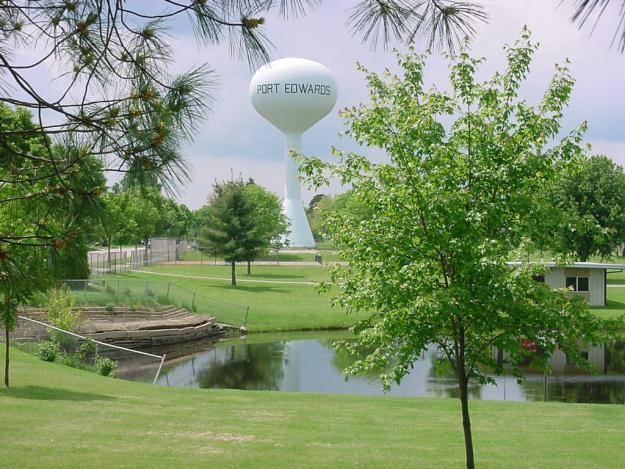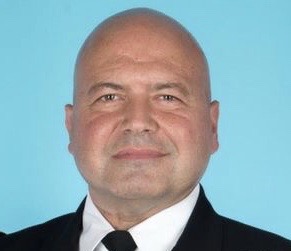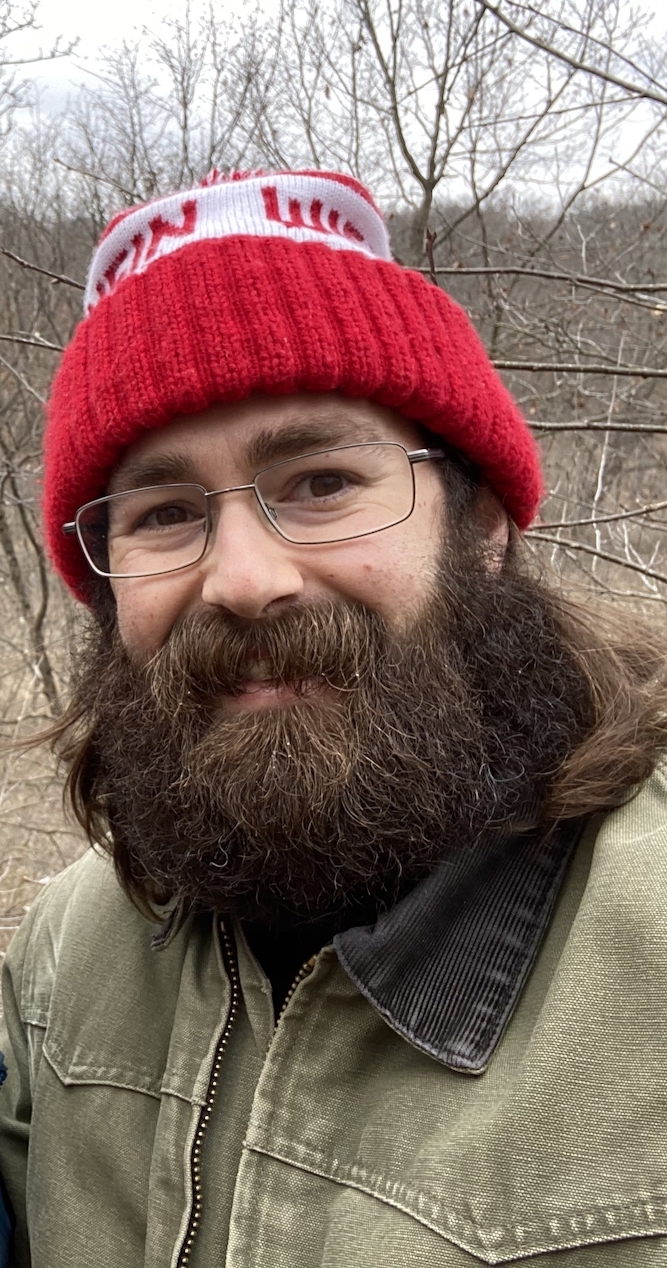Apply now to join our next cohort of Community Science Fellows and Community Leads!

The Port Edwards Water Tower provides water to our 1800 residents, located at Ripple Creek Park. Photo courtesy of Boz Bossert.
Water quality data are constantly generated, and the definition of water quality depends on the needs of the end-user. This project intends to 1) establish a clear definition of water quality within a specific community and 2) create a method for dissemination of water quality information that is easily accessible to this community. Although the definition of water quality can be complex, efforts to establish water quality standards among certain users and/or communities can be achieved through targeting public perceptions. After completion of this project the community will have a clear understanding of what water quality means, and how to access information on their own water quality.
Wood County, WI contains a population of 72,829 as of the 2020 census. Wood county comprises ~520,000 acres of primarily undeveloped lands, with two relatively large urban areas surrounding Marshfield in the north and Wisconsin Rapids and surrounding municipalities in the south, the latter of which contains The Village of Port Edwards. Of the undeveloped lands, nearly half is dedicated to cropland and pasture primarily in the northern half of the county. Undeveloped lands in the southern half of the county predominantly comprise recreational and forested areas. As such, Wood County represents a dichotomy of social and demographic structures, with agriculture dominating the north and recreational and residential in the south.
The village of Port Edwards is interested in developing water quality tools that are more accessible to citizens. The goal of the project is to develop a graphic user interface dashboard that pulls data from existing databases and displays information about water quality in a more accessible way. The dashboard will include a range of analytes that are consistently being tested for drinking water compliance, rather than providing information about only targeted analytes (e.g., only nitrates, lead, or other specific contaminants). A “total water quality” tool will be developed where an individual could input their address and view their water quality quickly and easily. Water quality data exists and is constantly being generated; the end result of this project will be to have this data be accessible and easy to understand for any person who is interested in their water quality.
The village of Port Edwards would like to lead the creation of the total water quality assessment tool, and in doing so establish a clear definition for water quality within the community. The project will primarily target any and all community members with questions or concerns about their water quality.
We envision a water quality “gauge”, containing three different color codes for different water quality conditions based on the availability of data that are pulled from public databases:
When the water quality gauge is within the amber or red zone, data and descriptions are provided that support the assessment. At this stage, individuals or communities can work together to develop a mitigation plan.
Water quality is regulated by the US Environmental Protection Agency and these regulations require that all public water utilities conduct regular testing of anthropogenic and geogenic contaminants, regardless of the source. Although the data are publicly available, dissemination is not always easy to use and understand by the general public. The water quality tool will provide a new means to access water quality data in a more comprehensible format.
The primary goal of this project is development of the graphical user interface for water quality. The datasets that will populate the water quality tool are already in place online. Once a scientist is recruited we hope the graphical user interface can be in place within three months, and then go live in six months. We expect that a testing phase will be involved after the tool is created prior to going live.

Raymond “Boz” Bossert Jr., Colonel (Retired), serves as the Village Administrator for the Village of Port Edwards. In this role, he is responsible for 37 Village employees, 15 square miles of Village limits, 50 miles of Village roadway, and 5 Village wells that provide over 600,000 gallons of water a month. Colonel Bossert’s 36 year Army Combat Engineer career in commanding troops in austere environments and establishing many large base camps gives him a unique perspective on water quality and its importance. He also has expertise and experience in Joint, Coalition, Inter-agency and Multi-National commands and over 14 combat deployments and assignments.
Colonel Bossert most recently served as the Senior Advisor on Engineering, Infrastructure and Economic Stabilization at the U.S. Army Peacekeeping and Stability Operations Institute. He feels that this partnership with Thriving Earth Exchange will energize this important project to provide Village residents a product that captures the true water quality of Wood County’s water sources. Ray’s Goal is to create a model for any community to provide a tangible “dashboard” style water quality tool for citizens, investors and developers in any City, Town or County.
Rober Kukla, Sr.- A Journeyman Skilled Tradesman for 48 years with expertise in system/equipment design, construction, installation, and Ongoing support. Proficient as a Steamfitter, Millwright, Machine Builder, Machine Repairman, and Field Engineer/Serviceman. Federally licensed as a First Class Powerplant Engineer. Taught Tradespeople within the Wisconsin VTAE System in the fields of Machine Repair, Maintenance Management, Machining, as well as Millwright Apprentices.
10 years in Management in Food Plant/Milling Operations as well as Municipal settings. I was one of a handful of individuals to to commission and support the startup of the $2.8B WPAP Project for the Milwaukee Metropolitan Sewerage District Jones Island Facility as well as the Deep Tunnel collections/storage operation. We established proper Maintenance planning, scheduling, equipment/system overhauls and total replacements. I was also tasked with assisting in establishing a proper equipment and spare component inventory as well as a chart of accounts to reflect system components and cost structure.
Hired on by the Quaker Oats Co. to establish a proper Maintenance program and correct a vast budgetary deficit for the world’s largest/oldest cereal plant/mill. Within 13 months the budget was improved and plant employee morale was restored. Subsequently I was involved in numerous large engineering endeavors and a company-wide capacity study. As a result of the plants’ metrics turnaround, the Company decide to close 3 other, more modern plants and retain the Cedar Rapids Plant which continues today. My Project Management endeavors ran in excess of $2.5M.
My reason for volunteering for this project is quite simple; I firmly believe water quality is paramount to a community’s health and well-being. Whether it is the potable water we consume, or the surface and underground water we live in, it is imperative that we, as shareholders do our best to keep the water we live with as clean and healthy for all to enjoy.
Bill Leichtnam (Retired)–A retired public-school teacher / coach, all at Nekoosa Public Schools–35 yrs. While there I was Nekoosa Teachers Association president & served on the Wisconsin State Social Studies Committee. Also taught Driver Education with a private driving school in the Tri-City area. Currently, in 4th term as Wood County Board Supervisor and Chairman of the Conservation, Education, & Economic Development committee. Town supervisor in Town of Saratoga. Also, “chair” of the Wood County Citizens Groundwater Group and Central Sands Groundwater County Collaborative (Juneau, Adams, Waushara, Wood, Portage, & Marquette counties).
My interest in “clean water” goes back to the 1970’s and owning a home north of Wisconsin Rapids with significant water issues (after two new wells being installed, still being only able to flush the toilet 3 times without running out of water and having water in the basement after every large rain or during the spring thaw). I also had the heartbreaking experience of listening to a former student who lives in the area explain how she lost her first child due to issues related to the mother unknowingly drinking polluted water; and then living in fear that her second-born would experience the same fate. In the 21st Century, “clean water” is a “must”; and it is too easily taken for granted.

Sean Scott is a scientist working in the Environmental Health Division of the Wisconsin State Laboratory of Hygiene. His educational background is in geological sciences, primarily focused on isotope geochemistry of many geological systems spanning a range of temperatures. He joined the State Lab in 2018 hoping to apply the methods and analytical techniques he learned as a geologist to problems more closely related to human health. His current research includes identifying sources of lead exposure in humans and animals, chemistry of groundwater systems used for drinking water, dynamics of atmospheric chemistry, chemistry of next generation nuclear power plant materials, the effects of technological advancement on archaeological populations, and other projects involving the fate and transport of heavy metals in the environment. The concept of community science appeals to Sean because it is a new way to get science, especially in the public health field, to better serve the people it is ultimately aiming to help and protect. In his free time, Sean enjoys music, hiking, biking, cooking, and otherwise hanging out with his family.
We seek a scientist with skillsets that will allow them to develop a computer program that pulls data from existing online databases and reformat that information into a graphic user interface. As this project is primarily focused on computer applications the scientist can be located anywhere. Student involvement is acceptable.
Thriving Earth Exchange asks all scientific partners to work with the community to help define a project with concrete local impact to which they can contribute as pro-bono volunteers and collaborators. This work can also position the scientists and communities to seek additional funding, together, for the next stage.
Interested in volunteering as a scientist? Apply now!
(c) 2024 Thriving Earth Exchange